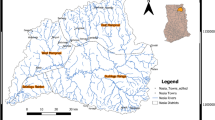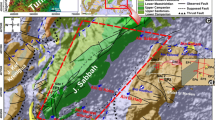In karst terrains with numerous soil caves and well-developed hydraulic flow channels it is important to document the spatial distribution of the geological hazard zones before a grouting program is initiated. These zones may well lead to excessive grout leakage that would require additional work to make the grout curtain effective. During the geological survey of the Dehou Reservoir site in Yunnan province, China, a combined survey method, including drilling process monitoring (DPM), cross-hole electrical resistivity tomography (C-ERT), and water pressure testing in boreholes (WPB), was used to identify the geological hazard zones in the karst terrain between grout curtain boreholes. The results from this survey showed that an integrated investigation can define the stratigraphic characteristics necessary to complete grouting projects successfully. The DPM, C-ERT, and WPB can be used to determine the locations of the preferential grout flow paths and the soil caves around a single borehole and map the distribution of unfavorable geology between boreholes. The data collected were sufficient to allow appropriate grouting parameters to be defined. Based on the analysis of the data obtained, empirical relationships between the penetration rate, the permeability, and the electrical resistivity were developed to evaluate the groutability of strata in this karst terrain. The mutually verifiable data obtained from these combined methods can lead to accurate and practical survey results.
Similar content being viewed by others
References
J. L. Lolcama, H. A. Cohen, and M. J. Tonkin, “Deep karst conduits, flooding, and sinkholes: lessons for the aggregates industry,” Eng. Geol., 65(2), 151-157 (2011).
K. I. Song, G. C. Cho, and S. B. Chang, “Identification, remediation, and analysis of karst sinkholes in the longest railroad tunnel in South Korea,” Eng. Geol., 135-136(7), 92-105 (2012).
V. I. Sheinin, “Use of ground surface caving model to predict karst cavity effect on soil mass deformation,” Soil Mech. Found. Eng., 54(4), 231-238 (2017).
I. A. DeBruyn and F. G. Bell, “The occurrence of sinkholes and subsidence depressions in the Far West Rand and Gauteg Province, South Africa and their engineering implications,” Environ. Eng. Geosci., 7, 281-295 (2001).
R. Martel, P. Castellazzi, E. Gloaguen, L. Trépanier, and J. Garfias, “ERT, GPR, InSAR, and tracer tests to characterize karst aquifer systems under urban areas: the case of Quebec City,” Geomorphology, 310, 45–56 (2018).
K. Chalikakis, V. Plagnes, R. Guerin, R. Valois, and F. P. Bosch, “Contribution of geophysical methods to karst-system exploration: an overview,” Hydrogeol. J., 19 (6), 1169-1180 (2011).
S. Li, S. Xu, L. Nie, B. Liu, R. Liu, and Q. Zhang, “Assessment of electrical resistivity imaging for pre-tunneling geological characterization: a case study of the Qingdao R3 metro line tunnel,” J. Appl. Geophys., 153, 38-46 (2018).
B. Liu, Z. Liu, S. Li, L. Nie, M. Su, H. Sun, K. Fan, X. Zhang, and Y. Pang, “Comprehensive surface geophysical investigation of karst caves ahead of the tunnel face: A case study in the Xiaoheyan section of the Water Supply Project from Songhua River, Jilin, China,” J. Appl. Geophys., 144, 37-49 (2017).
S. Li, B. Liu, X. Xu, L. Nie, Z. Liu, J. Song, H. Sun, L. Chen, and K. Fan, “An overview of ahead geological prospecting in tunneling,”. Tunn. Undergr. Sp. Tech., 63, 69-94 (2017).
Z. Q. Yue, C. F. Lee, K. T. Law, and, L. G. Tham, “Automatic monitoring of rotary-percussive drilling for ground characterization-illustrated by a case example in Hong Kong,” Int. J. Rock. Mech. Min., 41(4), 573-612 (2004).
D. Carbonel, V. Rodríguez-Tribaldos, F. Gutiérrez, J. P. Galve, J. Guerrero, M. Zarroca, C. Roqué, R. Linares, J. P. McCalpin, and E. Acosta, “Investigating a damaging buried sinkhole cluster in an urban area (Zaragoza city, NE Spain) integrating multiple techniques: geomorphological surveys, DInSAR, DEMs, GPR, ERT, and trenching,” Geomorphology, 229, 3-16 (2014).
D. I. Éppel’, “Investigatory experience gained with geologic-engineering conditions during activation of karst phenomena in the Moscow Region,” Soil Mech. Found. Eng., 45(3), 105-109 (2008).
F. Gutiérrez, J. P. Galve, and P. Lucha, “Integrating geomorphological mapping, trenching, InSAR and GPR for the identification and characterization of sinkholes: A review and application in the mantled evaporite karst of the Ebro Valley (NE Spain),” Geomorphology, 134, 144-156 (2011).
H. Rott, “Advances in interferometric synthetic aperture radar InSAR in earth system science,” Prog. Phys. Geog., 33, 769-791 (2009).
ASTM International, “Standard guide for selecting surface geophysical methods. Designation: D 6429-99,” ASTM, West Conshohocken, PA, 11-15 (2006).
L. Zini, C. Calligaris, E. Forte, L. Petronio, E. Zavagno, C. Boccali, and F. Cucchi, “A multidisciplinary approach in sinkhole analysis: the Quinis village case study (NE-Italy),” Eng. Geol., 197, 132-144 (2015).
Z. Q. Yue, “Drilling process monitoring for refining and upgrading rock mass quality classification methods (in Chinese),” Rock. Mech. Rock. Eng., 33(10), 1977-1996 (2014).
Author information
Authors and Affiliations
Corresponding author
Additional information
Translated from Osnovaniya, Fundamenty i Mekhanika Gruntov, No. 4, July-August, 2021.
Rights and permissions
About this article
Cite this article
Cao, R., Feng, S. Detection Methods for Unfavorable Geology and Soil Caves before Grouting in Karst Terrains. Soil Mech Found Eng 58, 308–313 (2021). https://doi.org/10.1007/s11204-021-09744-w
Published:
Issue Date:
DOI: https://doi.org/10.1007/s11204-021-09744-w




